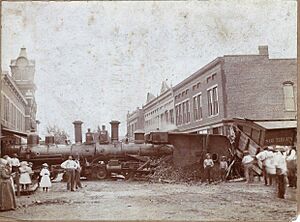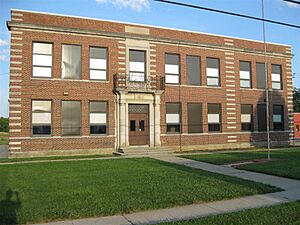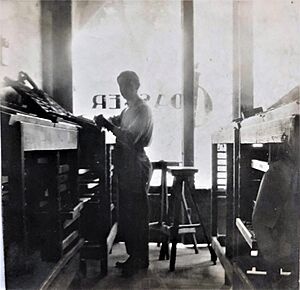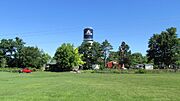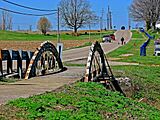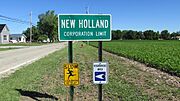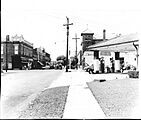New Holland, Ohio facts for kids
Quick facts for kids
New Holland, Ohio
|
|
|---|---|
|
Village
|
|
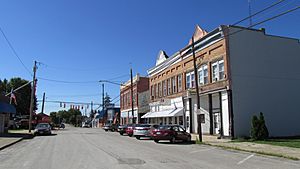
Looking south on North Main Street in New Holland
|
|
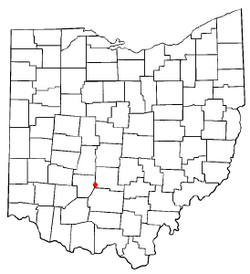
Location of New Holland, Ohio
|
|

Location of New Holland in Pickaway County
|
|
| Country | United States |
| State | Ohio |
| Counties | Pickaway, Fayette |
| Area | |
| • Total | 1.96 sq mi (5.07 km2) |
| • Land | 1.96 sq mi (5.07 km2) |
| • Water | 0.00 sq mi (0.00 km2) |
| Elevation | 853 ft (260 m) |
| Population
(2020)
|
|
| • Total | 804 |
| • Density | 410.62/sq mi (158.55/km2) |
| Time zone | UTC-5 (Eastern (EST)) |
| • Summer (DST) | UTC-4 (EDT) |
| ZIP code |
43145
|
| Area code(s) | 740 |
| FIPS code | 39-54726 |
| GNIS feature ID | 2399466 |
New Holland is a village in Fayette and Pickaway counties in Ohio, United States. The population was 804 at the 2020 census.
The Pickaway County portion of New Holland is part of the Columbus Metropolitan Statistical Area, while the Fayette County portion, often called West New Holland, is part of the Washington Court House Micropolitan Statistical Area.
Contents
Name
The town was originally founded as Flemingsburgh (or Flemingsburg) on September 2, 1818, and was named for John Fleming, son of Captain Fleming of Berkeley County, Virginia, who settled in the area in 1802. The name was later changed to New Holland between 1818 and 1827. The village was named after Holland, the native land of a share of the first settlers.
History
In 1818 the original settler's native of Pennsylvania Dutch, Hollanders, and Germans settled on "Four Corners," a tract of land in the Virginia Military District, granted to Wilkins Ogden in 1802. This tact was so called because it was, in a wilderness, the intersection of a stagecoach line running east and west, and an Indian foot trail going from north to south. This crossing is today the Main and Front Street intersection.
The settlement soon outgrew its descriptive name and was then called Flemingsburgh, for John Fleming, son of Captain Fleming of Berkeley County, Virginia, who settled in New Holland in 1802. The name remained until about 1825 when the people were thinking about having a Post Office. The settlers being of Dutch descent, renamed their settlement New Holland, the name it remains today.
Most of the houses were log cabins build in a small cluster. There were few business places for trading at that time.
The state chartered New Holland as a village in 1834.
One of the most dramatic events in New Holland's history came after the Civil War when a portion of General Sherman's Union Army marched through the covered bridge on Zanesville Cincinnati Trace [U.S. Route 22] and through New Holland. This covered bridge, which spanned over North Fork of Paint Creek on U.S. Route 22, was built in 1840, stood until 1943. Some have claimed that the old, covered bridge is now preserved in the Henry Ford Museum at Dearborn, Michigan. While Henry Ford did express admiration for the bridge, its remnants were used as scrap wood.
Train Wreck
Much excitement was created on the evening of September 18, 1899, at 8 p.m., when two trains collided head on in the middle of town, at the railroad crossing located on North Main Street.
Eastbound Engine 813 had been traveling at a high rate of speed and unbeknownst to its engineer, Charles Ditto, the train's caboose and a few cars had become uncoupled at Kingsfred (located just west of Johnson's Crossing in Union Township, Fayette County). As Engine 813 approached the village of New Holland Mr. Ditto spotted the oncoming westbound Engine 801. Setting off the train's whistle, beginning about 1/2 mile outside of New Holland, Ditto attempted to signal to the brakeman to slow down for a stop, still unaware that the caboose, where the brakeman was located, had become unattached. Realizing what had happened, Ditto quickly put his train into reverse, but it was too late to avoid a collision with the other oncoming train. The engineer of Engine 801, Joe Todhunter, by this time had noticed the approaching Engine 813. In an attempt to save his train and a large amount of freight being carried by the train, uncoupled his engine and three cars, sending them on to meet the approaching train. Eyewitness accounts claimed that the impact of the two trains was so forceful that it could be heard for several miles around. Both engines raised high into the air upon impact and crashed to the ground. Engine 801, a newer engine, suffered heavy damage, with one of its cars being completely demolished. Engine 813 meanwhile was completely destroyed, its tender being overthrown and seven of its cars were demolished, with most of them being thrown across the tracks. The impact had forced one of the cars over another after its wheels were sheared off. Another box car was broken into pieces, with about half of it being thrown and crashing into the back of the Gooley Brother's Implement Store. Fortunately, no injuries occurred as a result of the crash. Both engineers and firemen had jumped to safety just moments before the collision took place. Losses from the crash were estimated at $10,000 [roughly $373,891.67 today], and took workmen from about 10 p.m. that evening until the next morning to clean up the wreckage and debris.
Geography
According to the United States Census Bureau, the village has a total area of 1.88 square miles (4.87 km2), all land.
Demographics
| Historical population | |||
|---|---|---|---|
| Census | Pop. | %± | |
| 1870 | 326 | — | |
| 1880 | 478 | 46.6% | |
| 1890 | 683 | 42.9% | |
| 1900 | 824 | 20.6% | |
| 1910 | 804 | −2.4% | |
| 1920 | 810 | 0.7% | |
| 1930 | 741 | −8.5% | |
| 1940 | 777 | 4.9% | |
| 1950 | 799 | 2.8% | |
| 1960 | 798 | −0.1% | |
| 1970 | 796 | −0.3% | |
| 1980 | 783 | −1.6% | |
| 1990 | 841 | 7.4% | |
| 2000 | 785 | −6.7% | |
| 2010 | 801 | 2.0% | |
| 2020 | 804 | 0.4% | |
| U.S. Decennial Census | |||
2010 census
As of the census of 2010, there were 801 people, 308 households, and 212 families living in the village. The population density was 426.1 inhabitants per square mile (164.5/km2). There were 363 housing units at an average density of 193.1 per square mile (74.6/km2). The racial makeup of the village was 97.6% White, 0.2% African American, 0.4% Native American, 0.2% Asian, 1.0% from other races, and 0.5% from two or more races. Hispanic or Latino people of any race were 1.0% of the population.
There were 308 households, of which 33.8% had children under the age of 18 living with them, 51.3% were married couples living together, 9.4% had a female householder with no husband present, 8.1% had a male householder with no wife present, and 31.2% were non-families. 22.4% of all households were made up of individuals, and 11.4% had someone living alone who was 65 years of age or older. The average household size was 2.60 and the average family size was 3.06.
The median age in the village was 41.2 years. 22.7% of residents were under the age of 18; 8.3% were between the ages of 18 and 24; 24.3% were from 25 to 44; 30% were from 45 to 64; and 14.5% were 65 years of age or older. The gender makeup of the village was 50.4% male and 49.6% female.
Notable residents
- Terry Lyons, baseball player
Schools
Children residing in New Holland, Ohio, attend Miami Trace Local School District. However, the town historically held its own schooling. From its founding in 1887 until the last class graduated on May 27, 1959, New Holland High School served the community.
Media
Newspapers
The New Holland Review was published from 1877-1879.
The New Holland Leader was the community newspaper for 93 years. In 1887, it was established as Plain Talk. The name New Holland leader wasn't used until 1900. The Leader was a weekly newspaper, published each Thursday. The paper contained the news and events of the town. Births, marriages, deaths, the social happenings, the coming and going of the people, and notes from the schools and churches were just some other items that could be found in the Leader.
E.B. Lewis was the first publisher of the newspaper. other publishers throughout the years included:
| Years | Name |
|---|---|
| 1905-1921 | Percy May |
| 1921-1947 | Wendell Turner |
| 1947 | Earl Hinkle |
| 1947-1965 | Lawrence Hunter |
| 1965-1972 | Charles Mallory |
| 1972-1981 | Greenfield Times |
The Leader was printed for years in the back of the old post office located at 105 N. Main St. The Leader office was then moved across the street in March 1965. This remained the office until Charles Mallory sold the paper to the Greenfield Times. In January 1973, the Leader office was moved to 212 W. Front St. in the home of Mrs. Pat Funk. Mrs. Funk was the correspondent for the paper. The New Holland Leader ceased publication on January 1, 1981.
Gallery
See also
 In Spanish: New Holland (Ohio) para niños
In Spanish: New Holland (Ohio) para niños




